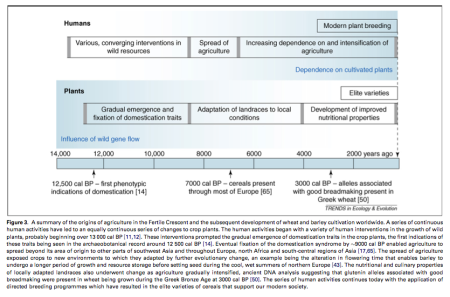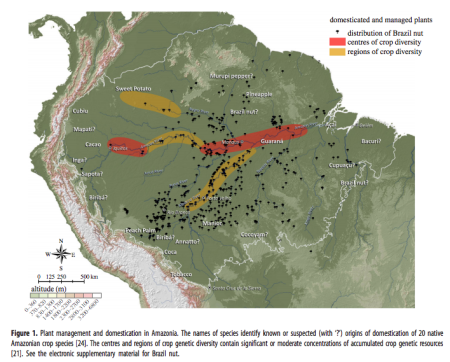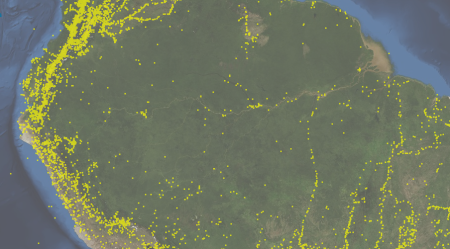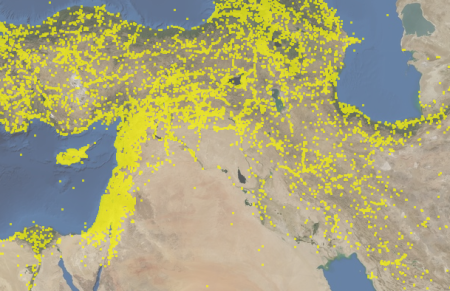- Secret of barley brittle rachis revealed. In other news, there’s a Centre of Excellence in Plant Cell Walls.
- Bramley apple pie filling protected. But from who?
- Participatively bred Oaxacan maize finds a market niche.
- Have some tequila with that participatively bred Oaxacan maize.
- “We can call a government and tell them our data is telling us that a pest is on the way.”
- The coolness of seeds.
- Yeah but “[g]ood seed in the wrong place is no longer good seed.”
Talking about Talking Biotech
Frankly, something called Talking Biotech would not normally get a second look from me. Too narrow. Too nerdy. Probably too preachy. But I’d be wrong in the case of Dr Kevin Folta’s podcast. It is nerdy, but in a good way; and it isn’t preachy (well, mostly not too preachy). And, despite it’s title, it’s not just about biotech. There tends to be a section in each hour-long weekly episode, usually towards the end, where an expert talks to Dr Folta about how a crop evolved, and how it is being improved: recent episodes include Dr David Spooner on the potato, Prof. Pat Heslop-Harrison on the banana, and Drs Shelby Ellison and Philipp Simon on the carrot. You can subscribe in iTunes, where you can also leave a review.
Early agriculture in the Old and New Worlds
Last week saw the publication of a couple of papers about early agriculture in two very different regions which will probably have people talking for quite a while. From Snir et al. 1 came a study of pre-Neolithic cultivation in the Near East. And from the other side of the world, there was the latest in the controversy over the extent of Amazonian agriculture from Clement et al. 2.
Yes, I did say pre-Neolithic. The key finding of the archaeological work described by the first paper is that 23,000 years ago, or over 11 millennia before the putative start of agriculture in the Fertile Crescent, hunter-gatherers along the Sea of Galilee in what is now Israel maintained little — and, crucially, weedy — fields of cereals. The archaeobotanists found remains of both the weeds and the cereals at a site called Ohalo II, as well as of sickles, and the cereals were not entirely “wild”, as the key domestication indicator of a non-brittle rachis was much more common than it should have been. To see what this means, have a look at this diagram from a fairly recent paper on agricultural origins in the region. 3

Those “first phenotypic indications of domestication”, dated at 12,500 years ago, need to be pushed quite a bit leftwards on that timeline now, off the edge in fact. A non-shattering rachis, it seems, was quite a quick trick for wild grasses to learn. But the process by which they acquired all the other traits that made them “domesticated” was very protracted and stop-start.
Zoom over to Amazonia, and the transition to farming took place much later, probably around 4,000 years ago, according to the other paper published last week. But it was just as significant as in the much better-known “cradle of agriculture” in the Fertile Crescent, with perhaps 80 species showing evidence of some domestication. The difference, of course, is that Amazonian agriculture was based on trees, rather than annual grasses and legumes.

According to the authors, parts of the Amazon basin, in particular those now showing evidence of earthworks and dark, anthropogenic soils, were just as much managed landscapes by the time of European contact as the places those Europeans came from. But compare our collections of crop diversity from the Amazon basin (courtesy of Genesys, which admittedly does not yet include Brazilian genebanks)…

with what we have from the Near East…

If we want to know more about how the domestication process and transition to agriculture differed in the Amazon and the Fertile Crescent, there’s a whole lot of exploration still to do.
Nibbles: Nutrition successes, Fruit grafting, Bee hero, VERY early ag, Humans bad shock, Biodiversity video
- Do you have a nutrition success story? Asking for IFPRI.
- What, another “Tree of 40 Fruit”?
- Bee expert Prof. Dave Goulson is a BBC conservation hero.
- Pre-Neolithic hunter-gatherers did some sort of semi-cultivation of some plants, in one place, at one time, maybe.
- Anthropogenic environmental change affecting pollinators and crop zinc levels shock.
- Video on biodiversity loss mentions crop diversity shock.
Brainfood: Grassland diversity, Potato diversity, English CWR, Genetic rescue, Saffron diversity, Lac, Cereal domestication, Turkish pea, Pathogen genomes, Rose fragrance, African cheese
- Worldwide evidence of a unimodal relationship between productivity and plant species richness. Grassland richness maximal at intermediate productivity levels.
- Cytoplasmic genome types of European potatoes and their effects on complex agronomic traits. Interesting relationships between cytoplasmic type on one hand and tuber starch content and resistance to late blight on other.
- Enhancing the Conservation of Crop Wild Relatives in England. 148 priority species, half of them not in ex situ at all. But there’s no excuse for that now.
- Genetic rescue to the rescue. Meaning an increase in population fitness, especially of rare species, owing to new alleles. Genomics will help by choosing the new alleles better, and monitoring the results.
- Diversity and relationships of Crocus sativus and its relatives analysed by IRAPs. No variation in the allotriploid cultigen, lots in the closely related species. Let the resynthesis begin.
- Economic analysis of Kusmi lac production on Zizyphus mauritiana (Lamb.) under different fertilizer treatments. That would be the scarlet resin secreted by some insects. NPK needed. No word on genetic differences.
- Parallel Domestication of the Heading Date 1 Gene in Cereals. Same QTL in sorghum, foxtail millet and rice, but different alterations of it. Multiple domestication for sorghum, single for foxtail millet.
- DNA based iPBS-retrotransposon markers for investigating the population structure of pea (Pisum sativum) germplasm from Turkey. No geographic structure for the landraces.
- The two-speed genomes of filamentous pathogens: waltz with plants. Fungi and oomycetes quite different genetically, but both have regions of genome which change rapidly to make them good pathogens. Bastards.
- The flowering of a new scent pathway in rose. Can we have our nice-smelling roses back now, please?
- AFLP assessment of the genetic diversity of Calotropis procera (Apocynaceae) in the West Africa region (Benin). Not just a weed, used in cheese-making, of all things.